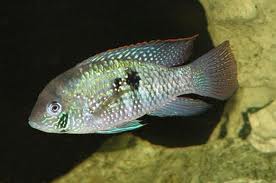
Common name: Blue Acara
Scientific name: Aequidens Pulcher
Average Adult Fish Size: 7 inches / 18 cm
Place of Origin: South and Central America.
Typical Tank setup: Although the Blue Acara will appreciate live plants, they are known to dig them up so strong roots and plenty of substrate is advised. Other than live plants it should be a typical South American cichlid arrangement with plenty of open swimming space as well as hiding places formed out of bogwood and rocks.
Recommended Minimum Aquarium Capacity: 60 gallon / 240 litre
Compatibility: The Blue Acara should be kept with similar sized South American Cichlids.
Temperature: 74 – 84 Deg F / 24 – 29 Deg C
Water chemistry: pH 5.5 – 7.0
Feeding: The Blue Acara is an omnivore and should be fed a variety of foods, such as frozen or freeze-dried brine shrimp, bloodworms, blackworms, flake food, and Cichlid pellets. Blue Acara also relish live food and should occasionally be provided with live brine shrimp, guppies, minnows, shrimp, worms, and crickets.
Sexing: A male Blue Acara will have more elongated dorsal and anal fins than a female.
Breeding: Blue Acara are dimorphic, egg layers that practice brood care. To induce breeding and sustain the ideal breeding environment, the water temperature should be raised to and maintained at about 86° F. The female Blue Acara will lay from 150-250 eggs in a carefully cleaned and selected location (driftwood, rocks, stones, slate, large plant leaves, etc). The eggs will hatch in 2-3 days and the fry should be swimming around within a week. A pair of Blue Acara will continue to breed every two weeks if the fry are constantly removed shortly after they hatch. The newly hatched fry can be fed a diet of baby brine shrimp and then moved to other foods as they mature.
Additional Information: Often confused with their more aggressive relative the Green Terror. It is a relatively aggressive species which inhabits still to slow moving waters in the wild.


Related Posts
Croaking Gourami – Trichopsis vittatus
Paradise Fish – Macropodus opercularis
Schubert’s Barb – Barbus Semifasciolatus